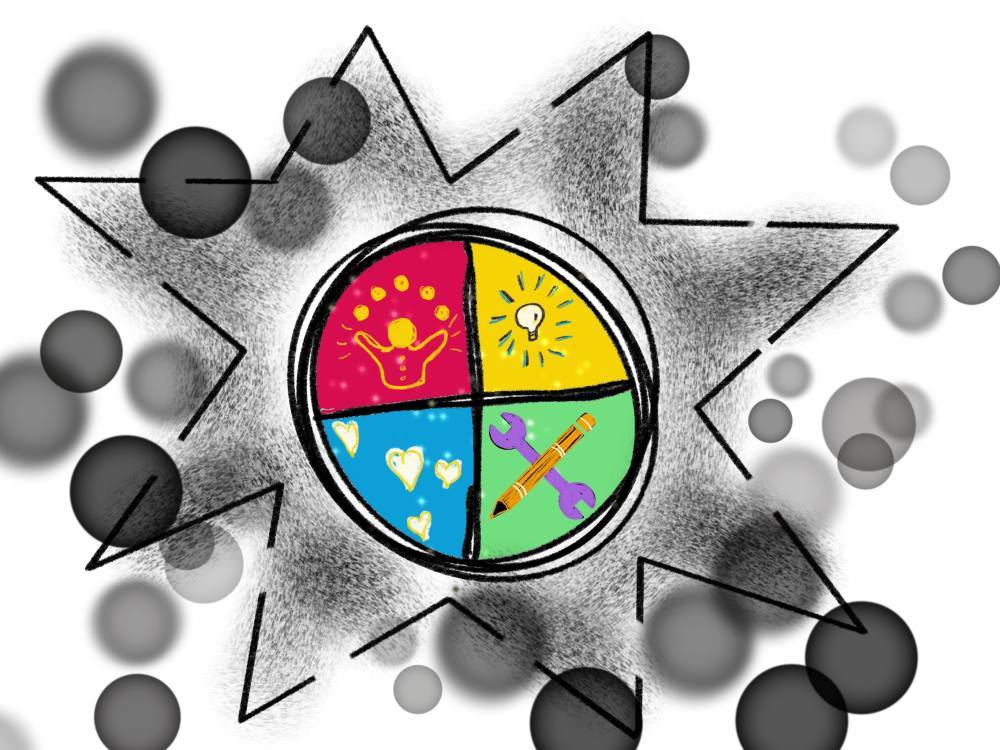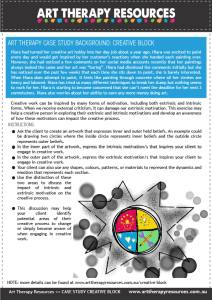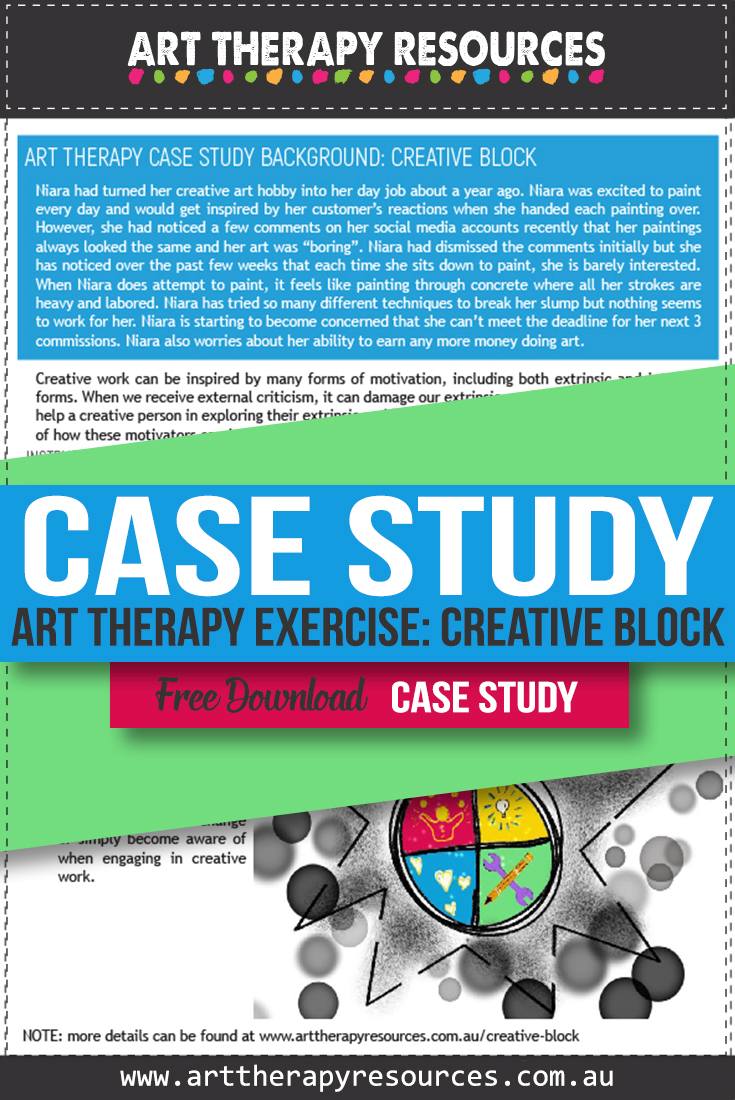THIS POST INCLUDES:
- Art Therapy and Creative Blocks
- About the Client
- Art Therapy Exercise
- Client Insight and Outcomes
- Disclaimer
- FREE DOWNLOAD Art Therapy Exercise
ART THERAPY AND CREATIVE BLOCKS
Creative blocks can be experienced by a wide range of professionals (writers, musicians, artists, performers, designers, etc) and hobbyists. For a professional, it can be debilitating if their primary source of income is impacted by a creative block.
Outside of professional creatives, having a creative block can also be difficult for anyone who uses creativity as an enjoyable hobby or for those who engage in creative endeavors as part of their life healing.
Creative blocks can last from a day to weeks, months, or years. Creative blocks primarily affect performance, however many side effects can develop as a result of a reduction in creative activity. This can include anxiety, depression, poor sleep, emotional dysregulation, and an overall reduction in mental well-being.
TYPES OF CREATIVE BLOCKS
Most of us assume a creative block means you can’t generate new ideas, however, there are many different creative blocks that people may experience:
- Mental blocks – imposter syndrome, perfectionism, lack of motivation
- Emotional blocks – self-doubts, fears
- Work process blocks – when work routines become unhelpful to your creative process
- Distractions and disruptions – when life circumstances affect your ability to work
Understanding the different types of creative blocks that exist can help a therapist identify the most direct way they can help a potential client who is experiencing a creative block.
Of course, not all creative blocks need to be pathologized. Creative endeavors require a significant effort to imagine and develop ideas from nothing. There is often no handbook or mode of operation when working within a creative job.
In these situations, creative blocks can be viewed as part of the job and could be remedied by establishing some work protocols that can facilitate a conducive work environment. This can be as simple as ensuring you have an organised work space through to developing work routines that designate time for creative work and administrative work if these two roles are causing conflict.
Some common suggestions for developing a productive creative workflow include:
- Set a schedule to create – apply realistic timeframes and deadlines for your work
- Prepare your ideas – research your idea, gather your resources and create an inspiring work environment
- Just start – avoid analysis paralysis and just get something down
- Goal setting – set goals and rewards when you’ve achieved your goals
CAUSES OF CREATIVE BLOCKS
Creative blocks can occur for many reasons including some of the below:
- Perceived pressure to continue previous successes
- Fear of rejection
- Persistent rejection of creative work by critics/public
- Fear of failure
- Burnout from high output
- Pursuit of perfectionism
- Physical illness or condition affecting cognitive functioning
- Physical illness or condition affecting physical functioning for creating
- Major life changes (relationship breakdown, trauma, etc)
HOW ART THERAPY CAN HELP WITH CREATIVE BLOCK
Your client may feel that art therapy won’t work for them if they already feel creatively blocked. This belief is an opportunity for an art therapist to reiterate the importance of art therapy embracing process over product. The process of making the art is more important than the final art piece that is created.
Art therapy can help the individual explore the causes of their creative block if this is unknown to them. Even if the client holds a belief about the cause for their creative block, art therapy can help the individual explore any hidden thoughts and feelings they may hold about their self-worth and ability to connect with their creativity.
Art therapy provides a space for the client to abandon their typical creative process and use art in a therapeutic setting to explore other avenues of themselves aside from being a professional creative.
Some clients may feel comfortable exploring internal thoughts and beliefs they hold through art therapy if they feel a connection and comfort through using familiar art materials. This familiarity may assist clients in feeling competent in the therapeutic process if they are feeling disconnected from their craft.
Art therapy with an art therapist may also provide a feeling of collaboration and shared experiences. Creative people often find their work is created alone which can be helpful when a creative person is working with flow, however, it can also feel isolating when successes and difficulties are not shared with creative peers.
ABOUT THE CLIENT
- Name: Niara
- Age: 55
CURRENT CLIENT ISSUES:
Niara had turned her creative art hobby into her day job about a year ago. Niara was excited to paint every day and would get inspired by her customer’s reactions when she handed each painting over. However, she had noticed a few comments on her social media accounts recently that her paintings always looked the same and her art was “boring”.
Niara had dismissed the comments initially but she has noticed over the past few weeks that each time she sits down to paint, she is barely interested. When she does attempt to paint, it feels like painting through concrete where all her strokes are heavy and labored.
Niara has tried so many different techniques to break her slump but nothing seems to work for her. Niara is starting to become concerned that she can’t meet the deadline for her next 3 commissions. Niara also worries about her ability to earn any more money doing art.
ART THERAPY EXERCISE
Creative work can be inspired by many forms of motivation, including both extrinsic and intrinsic forms. When we receive external criticism, it can damage our extrinsic motivation.
This exercise may help a creative person in exploring their extrinsic and intrinsic motivations and develop an awareness of how these motivators can impact the creative process.
INSTRUCTIONS:
- Ask the client to create an artwork that expresses inner and outer held beliefs. An example could be drawing two circles where the inside circle represents inner beliefs and the outside circle represents outer beliefs.
- In the inner part of the artwork, express the intrinsic motivation/s that inspires your client to engage in creative work.
- In the outer part of the artwork, express the extrinsic motivation/s that inspires your client to engage in creative work.
- Your client can also use any shapes, colours, patterns, or materials to represent the dynamics and emotion that represents each section.
- Use the distinction of these two areas to discuss the impact of intrinsic and extrinsic motivation on the creative process.
- This discussion may help your client identify potential areas of their creative process to change or simply become aware of when engaging in creative work.
CLIENT INSIGHT AND OUTCOMES
Niara noted her inner motivations for creating were the joy and fun she felt when creating, the emotions she could express, the ideas she could generate, and the new skills she was developing with each new artwork.
Niara also noted her external motivations were often out of her control and belonged to other people. Each person has their motivation for liking or disliking her artwork and to be focused on those motivations was creating a lot of noise and disjointed feelings in her work.
Through creating the artwork, Niara felt clearer about what she loved about creating. Niara mentioned she was going to keep this artwork in her studio and create a ritual before each painting session that would focus on her intrinsic motivation for creating – fun, expression, ideas, and skills.

DISCLAIMER
This case study represents a snapshot of the client’s progress in treatment. The exercise in this article could be used as written or as a guide for new and original tasks developed by the Art Therapist. Responsibility for treatment resides with the individual therapist who understands their clients specific needs. The art therapy exercise should not be viewed as a pre-defined directive on how to treat a client that presents with a specific range of problems.This art therapy exercise will help build a database of knowledge to draw upon when helping your client. Art Therapy is associated with psychotherapy techniques, however each therapist often approaches therapy with their own foundation of psychological interventions, whether it be psychotherapy, CBT, DBT or other methods.
FREE DOWNLOAD: Art Therapy Exercise
Download the FREE Art Therapy Exercise based on the above Case Study. The free download includes instructions for the art therapy exercise, along with an example of the art therapy exercise.

BUILD YOUR ART THERAPY REFERENCE MATERIALS:
Pin this image to your Pinterest board.

SHARE KNOWLEDGE & PASS IT ON:
If you’ve enjoyed this post, please share it on Facebook, Twitter, Pinterest. Thank you!
